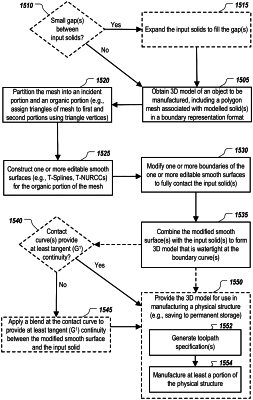| CPC G05B 19/4099 (2013.01) [B23Q 3/16 (2013.01); B29C 64/393 (2017.08); B33Y 50/00 (2014.12); B33Y 50/02 (2014.12); G06F 30/10 (2020.01); G05B 2219/35134 (2013.01); G05B 2219/49007 (2013.01); G06F 2113/10 (2020.01); G06F 2119/18 (2020.01)] | 33 Claims |

|
1. A method comprising:
obtaining, in a computer aided design program, a first three-dimensional model of an object to be manufactured, wherein the first three-dimensional model comprises a polygon mesh resulting from a generative design process employing one or more input solids as one or more sub-spaces of an optimization domain of the generative design process, the one or more input solids being in a boundary representation format;
partitioning, by the computer aided design program, the polygon mesh into a first portion that is incident with the one or more input solids and a second portion that is not incident with the one or more input solids;
constructing, by the computer aided design program, one or more editable smooth surfaces for the second portion of the polygon mesh, wherein each of the one or more editable smooth surfaces has a globally smooth parameterization, which permits globally smooth free-form surface editing;
modifying, by the computer aided design program, one or more boundaries of the one or more editable smooth surfaces to contact the one or more input solids at one or more contact curves that are homeomorphic to an unmodified boundary between the one or more modified smooth surfaces and the one or more input solids; and
combining, by the computer aided design program, the one or more modified smooth surfaces with the one or more input solids to form a second three-dimensional model of the object to be manufactured, wherein the second three-dimensional model comprises the one or more modified smooth surfaces in contact with one or more portions of the one or more input solids in the boundary representation format at one or more gap-free contact curves, wherein the second three-dimensional model is watertight, and wherein each of the one or more gap-free contact curves and each of the one or more modified smooth surfaces is editable using free-form modeling operations.
|